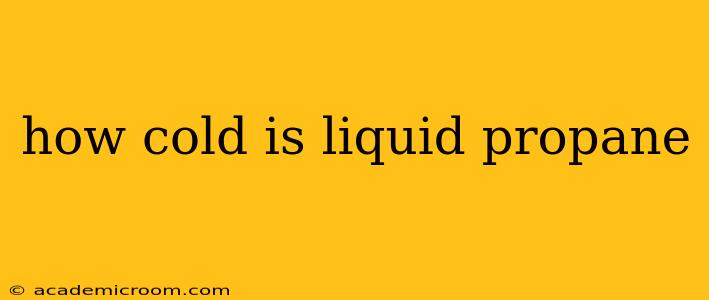How Cold is Liquid Propane? Understanding Propane's Temperature and Applications
Liquid propane, a common fuel source for heating, cooking, and vehicles, exists at a significantly lower temperature than its gaseous counterpart. Understanding this temperature is crucial for safe handling and efficient use. But how cold is it? Let's delve into the details.
The Boiling Point of Propane:
The key to understanding how cold liquid propane is lies in its boiling point. At standard atmospheric pressure (1 atmosphere), liquid propane boils at -44°F (-42°C). This means that at this temperature, liquid propane transitions into a gas. It's important to note that this temperature can vary slightly depending on pressure. Higher pressures will result in a higher boiling point.
What Happens Below the Boiling Point?
Below -44°F (-42°C), propane remains in its liquid state. However, even at temperatures slightly above the boiling point, propane will still partially vaporize, especially if exposed to warmer surroundings. This is why propane tanks often have pressure relief valves—to prevent pressure buildup from vaporization.
How Cold is Liquid Propane Compared to Other Substances?
To put this temperature into perspective, consider these comparisons:
- Dry Ice: Dry ice (solid carbon dioxide) sublimates (transitions directly from solid to gas) at -109.3°F (-78.5°C), making it considerably colder than liquid propane.
- Water: Water freezes at 32°F (0°C) and boils at 212°F (100°C), highlighting the significant temperature difference between water and liquid propane.
- Liquid Nitrogen: Liquid nitrogen boils at -320.4°F (-195.8°C), significantly colder than propane.
How is Liquid Propane Kept Cold?
While liquid propane boils at -44°F (-42°C), it's typically stored and transported under pressure. This pressure keeps the propane in its liquid state even at higher ambient temperatures. The pressure within the tank prevents boiling and maintains the liquid form. When you use propane, the pressure is released, allowing the liquid to vaporize and become usable gas.
Safety Considerations Regarding Liquid Propane's Temperature:
Because of its low boiling point, it's essential to handle liquid propane with care. Direct contact with liquid propane can cause severe frostbite due to rapid freezing. Always wear appropriate safety gear, including gloves and eye protection, when handling propane.
What are the applications of liquid propane?
Liquid propane's low boiling point makes it ideal for various applications, including:
- Heating: Homes, businesses, and agricultural operations utilize propane for heating.
- Cooking: Propane stoves and grills are common in residential and commercial settings.
- Motor Fuel: Propane autogas is a cleaner-burning alternative to gasoline.
- Industrial Processes: Several industrial applications leverage propane's properties for various processes.
This information provides a comprehensive understanding of liquid propane's temperature and related safety and application aspects. Remember always to consult safety guidelines and regulations when handling this substance.
